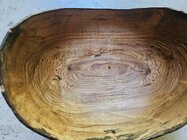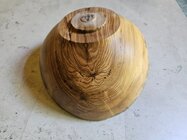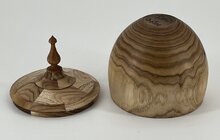-
December 2025 Turning Challenge: Single Tree! (click here for details) -
Congratulations to Bob Henrickson, People's Choice in the November 2025 Turning Challenge (click here for details) -
Congratulations to Guillaume Fontaine for "Old Tea Pot" being selected as Turning of the Week for December 15, 2025 (click here for details) -
Welcome new registering member. Your username must be your real First and Last name (for example: John Doe). "Screen names" and "handles" are not allowed and your registration will be deleted if you don't use your real name. Also, do not use all caps nor all lower case.
You are using an out of date browser. It may not display this or other websites correctly.
You should upgrade or use an alternative browser.
You should upgrade or use an alternative browser.
Wood Identification
- Thread starter Ed Weingarden
- Start date
Definitely the classic "Spiderwood". 
Looks like it could be olive wood.
@Don Wattenhofer - it's not very soft, and the color is more of a golden brown. Thanks for your thoughts.
Spiderwood - I like it
Spiderwood - I like it
Looks like olive ash to me.
I agree with Richard. Olive Ash
I'm not familiar with Olive Ash. Is it Ash that looks like Olive, Olive that looks like Ash, or something else?
Check out the hardwood database for a bunch of information about Olive Ash: https://www.wood-database.com/olive-ash/I'm not familiar with Olive Ash. Is it Ash that looks like Olive, Olive that looks like Ash, or something else?
Basically, some Ash trees have grain patterns/colors in their heartwood that is reminiscent of Olive wood.
Russ Braun
TOTW Team
Twice in the same month…olive ash! Having never heard of it in the last 40 yrs, that’s numerous to moi, lol!!Check out the hardwood database for a bunch of information about Olive Ash: https://www.wood-database.com/olive-ash/
Basically, some Ash trees have grain patterns/colors in their heartwood that is reminiscent of Olive wood.
Olive ash is used to describe the heart wood when, more so in older trees, it turns an olive brown color. Only had it once and the bowls would fly off my shelves at the shows! I am not sure if that is olive ash or not. the grain just doesn't look right to me. Maybe because our western ash has different growth rings and the eastern stuff grows more slowly. I had some butternut once. It was green, and smelled like vinegar. The branch growth rings were scalloped, which I heard was typical for butternut. Made for a very nice spider web pattern in the bowls.
robo hippy
robo hippy
I'm not familiar with a lot of wood species, but I am familiar with a lot at the same time.I'm not familiar with Olive Ash. Is it Ash that looks like Olive, Olive that looks like Ash, or something else?
@Michael Anderson - thanks for the link and the info.
If it matters, one option for ID is to take a small offcut with end grain (doesn't need to be large), make a smooth cut with a single-edged razor blade to get a clean look at the end grain, and see if it looks like one of these (or one of the other species in the Wood Database - all somewhat similar (big surprise!) - keeping in mind that every tree is unique in some ways, depending on how and where it grew.
Look for the earlywood and latewood pores, and, annual boundary, and the rays (almost invisible). If it's Ash, the earlywood pores will be open (empty).
The Wood Database includes more species but I just pulled out, er, pilfered these four. It's recommended to use a 10x magnifier. More instructions are on the Wood Database in the wood ID article, section 7.

If this is hard to do, perhaps someone in your club has such experience.
JKJ
Look for the earlywood and latewood pores, and, annual boundary, and the rays (almost invisible). If it's Ash, the earlywood pores will be open (empty).
The Wood Database includes more species but I just pulled out, er, pilfered these four. It's recommended to use a 10x magnifier. More instructions are on the Wood Database in the wood ID article, section 7.

If this is hard to do, perhaps someone in your club has such experience.
JKJ
@JKJ - that's an interesting idea, but I don't have anymore of the wood. Thanks for the suggestion.
@JKJ - that's an interesting idea, but I don't have anymore of the wood. Thanks for the suggestion.
Ah, unfortunate. Maybe next time cut off and save a corner or something. All that's usually needed is a piece with about 1/2" of end grain.
JKJ



